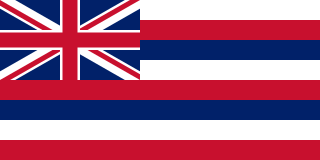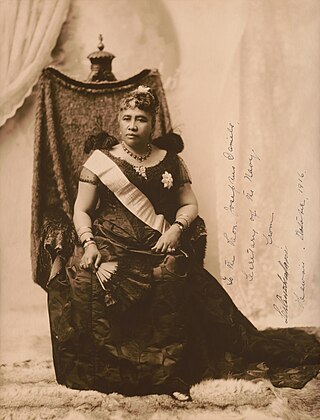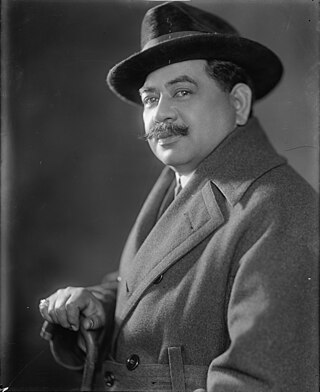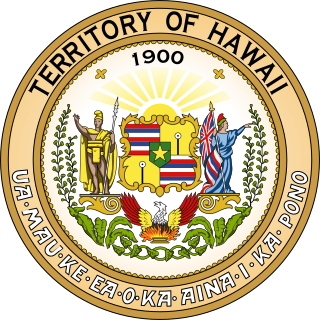
Hawaii is an island state of the United States, in the Pacific Ocean about 2,000 miles (3,200 km) southwest of the U.S. mainland. It is the only state not on the North American mainland, the only state that is an archipelago, and the only state in the tropics. It also hosts 10 out of 14 climates - the highest for any country subdivision - and is one of two U.S. states with a tropical climate.

Since Hawaii became a state in 1959, it has sent congressional delegations to the United States Senate and United States House of Representatives. Each state elects two senators to serve for six years. Members of the House of Representatives are elected to two-year terms, one from each of Hawaii's congressional districts. Before becoming a state, the Territory of Hawaii elected a non-voting delegate at-large to Congress from 1900 to 1958.

Kalawao County is a county in the U.S. state of Hawaii. It is the smallest county in the 50 states by land area and the second-smallest county by population, after Loving County, Texas. The county encompasses the Kalaupapa or Makanalua Peninsula, on the north coast of the island of Molokaʻi. The small peninsula is isolated from the rest of Molokaʻi by cliffs over a quarter-mile high; the only land access is a mule trail.

The Republic of Hawaii was a short-lived one-party state in Hawaiʻi between July 4, 1894, when the Provisional Government of Hawaii had ended, and August 12, 1898, when it became annexed by the United States as an unincorporated and unorganized territory. In 1893, the Committee of Public Safety overthrew Queen Liliʻuokalani, the monarch of the Kingdom of Hawaiʻi, after she rejected the 1887 Bayonet Constitution. The Committee of Public Safety intended for Hawaii to be annexed by the United States; however, President Grover Cleveland, a Democrat opposed to imperialism, refused. A new constitution was subsequently written while Hawaii was being prepared for annexation.

Liliʻuokalani was the only queen regnant and the last sovereign monarch of the Hawaiian Kingdom, ruling from January 29, 1891, until the overthrow of the Hawaiian Kingdom on January 17, 1893. The composer of "Aloha ʻOe" and numerous other works, she wrote her autobiography Hawaiʻi's Story by Hawaiʻi's Queen (1898) during her imprisonment following the overthrow.

Jonah Kūhiō Kalanianaʻole was a prince of the Kingdom of Hawaiʻi until it was overthrown by a coalition of American and European businessmen in 1893. He later went on to become a representative in the Territory of Hawaii as delegate to the United States Congress, and as such is the only royal-born member of Congress.

The Territory of Hawaii or Hawaii Territory was an organized incorporated territory of the United States that existed from April 30, 1900, until August 21, 1959, when most of its territory, excluding Palmyra Island, was admitted to the United States as the 50th US state, the State of Hawaii. The Hawaii Admission Act specified that the State of Hawaii would not include Palmyra Island, the Midway Islands, Kingman Reef, and Johnston Atoll, which includes Johnston Island and Sand Island.

Maro Reef is a largely submerged coral atoll located in the Northwestern Hawaiian Islands. It was discovered in 1820 by Captain Joseph Allen of the ship Maro, after whose ship the reef was named. With a total area of 747 square miles (1,935 km2), it is the largest coral reef in the Northwestern Hawaiian Islands. It contains 37 species of stony coral. Unlike most atolls, the coral extends out from the center like spokes on a wheel. Located about 850 miles northwest of Honolulu, Hawaii, Maro Reef contains about 1 acre (4,000 m2) of dry land which itself can be submerged depending on the tides. Some scientists believe that it "may be on the verge of drowning" because the reefs are detached and are vulnerable to strong storm waves.

The Newlands Resolution, 30 Stat. 750, was a joint resolution passed on July 7, 1898, by the United States Congress to annex the independent Republic of Hawaii. In 1900, Congress created the Territory of Hawaii.
The Hawaiian Independent Party, was a political party active in Hawaii from 1900 to 1912, during which time Hawaii was controlled by the United States and administered as the Territory of Hawaii. The Party was established by Robert Wilcox, immediately after the United States annexed the Hawaiian Islands with the Newlands Resolution in 1898 and established the Territory of Hawaii with the Hawaiian Organic Act in 1900. The party was formed to represent and advocate for the rights and interests of Native Hawaiians, many of whom were then inclined to believe that both the Democratic Party of Hawai‘i and Hawai‘i Republican Party were yet incapable of representing them.

The Hawaii Republican Party is the affiliate of the Republican Party (GOP) in Hawaii, headquartered in Honolulu. The party was strong during Hawaii's territorial days, but following the Hawaii Democratic Revolution of 1954 the Democratic Party came to dominate Hawaii. The party currently has little power and is the weakest state affiliate of the national Republican Party; it controls none of Hawaii's statewide or federal elected offices and has the least presence in the state legislature of any state Republican party.
A Hawaiian name is a name in the Hawaiian language. Such names are popular not only in Hawaiian families, but also among other residents of Hawaii, and even in the United States mainland among both non-native and native Hawaiians.

The Democratic Party of Hawaiʻi is the affiliate of the Democratic Party in the state of Hawaii.

The Hawaiian Organic Act, Pub. L.Tooltip Public Law 56–339, 31 Stat. 141, enacted April 30, 1900, was an organic act enacted by the United States Congress to establish the Territory of Hawaii and to provide a Constitution and government for the territory. The Act was replaced by the Hawaii Admission Act on August 21, 1959, when the territory was admitted to the Union as the State of Hawaii.

Hawaii Territory's at-large congressional district was the congressional district for the Territory of Hawaii, which was established by the Newlands Resolution of 1898.

The Chinatown Historic District is a neighborhood of Honolulu, Hawaii, known for its Chinese American community. It is one of the oldest Chinatowns in the United States.
The Minister of Foreign Affairs was a powerful office in the Kingdom of Hawaii, the Provisional Government of Hawaii and the Republic of Hawaii from 1843 to 1900. It made up one of the four offices of the monarchical or presidential cabinet which advised the Head of State of Hawaii on executive affairs. During the monarchy, ministers were also ex-officio members of the Privy Council and the House of Nobles in the legislature. During the republic, ministers were ex-officio members of both houses of the legislature. The head of state had the power to appoint the ministers but later Hawaiian constitutions limited the power the head of state had in removing the cabinet ministers by requiring a vote of no confidence from a majority of the elective members of the legislature. All acts of the head of state had to be countersigned by a minister.
The Minister of the Interior was a powerful office in the Kingdom of Hawaii, the Provisional Government of Hawaii and the Republic of Hawaii from 1845 to 1900. It made up one of the four offices of the monarchical or presidential cabinet which advised the Head of State of Hawaii on executive affairs. During the monarchy, ministers were also ex-officio members of the Privy Council and the House of Nobles in the legislature. During the republic, ministers were ex-officio members of both houses of the legislature. The head of state had the power to appoint the ministers but later Hawaiian constitutions limited the power the head of state had in removing the cabinet ministers by requiring a vote of no confidence from a majority of the elective members of the legislature. All acts of the head of state had to be countersigned by a minister.

The Hawaii Territorial Legislature was the legislative body of the Territory of Hawaii from 1900 to 1959.
Ryukyuan Americans are Americans who are fully or partially of Ryukyuan descent. The vast majority of them trace their family history to the Okinawa Islands.


















